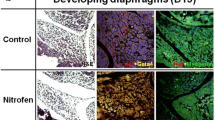Abstract
Background
Normal development of the fetal diaphragm requires muscularization of the diaphragm as well as the structural integrity of its underlying connective tissue components. Developmental mutations that inhibit the formation of extracellular matrix (ECM) have been shown to result in congenital diaphragmatic hernia (CDH). Copper (Cu) is an important element during diaphragm morphogenesis by participating in cross-linking of collagen and elastin fibers. Cu transport is strictly regulated by two membrane proteins: Cu-uptake transporter 1 (CTR1) and the Cu-efflux pump ATP7A. Animals lacking Cu-dependent enzymes exhibit abnormal connective tissue with diaphragmatic defects. However, the molecular basis of disruptions in Cu-mediated ECM formation in CDH remains unclear. We designed this study to investigate the hypothesis that diaphragmatic expression of CTR1 and ATP7A is decreased in the nitrofen-induced CDH model.
Methods
Timed-pregnant rats were exposed to either nitrofen or vehicle on gestational day 9 (D9), and fetuses were harvested on selected time-points D15 and D18. Microdissected fetal diaphragms (n = 48) were divided into control and nitrofen-induced CDH samples (n = 12 per experimental group and time-point). Diaphragmatic gene expression levels of CTR1 and ATP7A were analyzed by quantitative real-time polymerase chain reaction. Immunohistochemistry was performed to evaluate CTR1 and ATP7A protein expression in fetal diaphragms, which was combined with specific rhodanine staining to determine diaphragmatic Cu content.
Results
Relative mRNA levels of CTR1 and ATP7A were significantly reduced in diaphragms of nitrofen-exposed fetuses on D15 (0.06 ± 0.02 vs. 0.18 ± 0.08; p < 0.05 and 0.04 ± 0.02 vs. 0.08 ± 0.02; p < 0.05) and D18 (0.10 ± 0.03 vs. 0.17 ± 0.02; p < 0.05 and 0.09 ± 0.03 vs. 0.16 ± 0.04; p < 0.05) compared to controls. Immunoreactivity of CTR1 and ATP7A was markedly decreased in the malformed diaphragmatic ECM of nitrofen-exposed fetuses on D15 and D18, which was associated with a significantly decreased diaphragmatic Cu content on D15 (7.22 ± 2.91 vs. 17.50 ± 3.09; p < 0.05) and D18 (17.60 ± 3.54 vs. 28.20 ± 4.63; p < 0.05) compared to controls.
Conclusion
Reduced diaphragmatic expression of CTR1 and ATP7A during morphogenesis may impair the activity of Cu-dependent enzymes and thus contribute to defective ECM during diaphragmatic development.

Similar content being viewed by others
References
Loane M, Dolk H, Kelly A, Teljeur C, Greenlees R, Densem J (2011) Paper 4: EUROCAT statistical monitoring: identification and investigation of ten year trends of congenital anomalies in Europe. Birth Defects Res A Clin Mol Teratol 91(Suppl 1):S31–S43. doi:10.1002/bdra.20778
Tovar JA (2012) Congenital diaphragmatic hernia. Orphanet J Rare Dis 7:1. doi:10.1186/1750-1172-7-1
Clugston RD, Klattig J, Englert C, Clagett-Dame M, Martinovic J, Benachi A, Greer JJ (2006) Teratogen-induced, dietary and genetic models of congenital diaphragmatic hernia share a common mechanism of pathogenesis. Am J Pathol 169(5):1541–1549. doi:10.2353/ajpath.2006.060445
Montedonico S, Nakazawa N, Puri P (2008) Congenital diaphragmatic hernia and retinoids: searching for an etiology. Pediatr Surg Int 24(7):755–761. doi:10.1007/s00383-008-2140-x
Noble BR, Babiuk RP, Clugston RD, Underhill TM, Sun H, Kawaguchi R, Walfish PG, Blomhoff R, Gundersen TE, Greer JJ (2007) Mechanisms of action of the congenital diaphragmatic hernia-inducing teratogen nitrofen. Am J Physiol Lung Cell Mol Physiol 293(4):L1079–L1087. doi:10.1152/ajplung.00286.2007
Clugston RD, Greer JJ (2007) Diaphragm development and congenital diaphragmatic hernia. Semin Pediatr Surg 16(2):94–100. doi:10.1053/j.sempedsurg.2007.01.004
Greer JJ (2013) Current concepts on the pathogenesis and etiology of congenital diaphragmatic hernia. Respir Physiol Neurobiol 189(2):232–240. doi:10.1016/j.resp.2013.04.015
Merrell AJ, Kardon G (2013) Development of the diaphragm: a skeletal muscle essential for mammalian respiration. FEBS J 280(17):4026–4035. doi:10.1111/febs.12274
Maki JM, Sormunen R, Lippo S, Kaarteenaho-Wiik R, Soininen R, Myllyharju J (2005) Lysyl oxidase is essential for normal development and function of the respiratory system and for the integrity of elastic and collagen fibers in various tissues. Am J Pathol 167(4):927–936. doi:10.1016/S0002-9440(10)61183-2
Hornstra IK, Birge S, Starcher B, Bailey AJ, Mecham RP, Shapiro SD (2003) Lysyl oxidase is required for vascular and diaphragmatic development in mice. J Biol Chem 278(16):14387–14393. doi:10.1074/jbc.M210144200
Rucker RB, Romero-Chapman N, Wong T, Lee J, Steinberg FM, McGee C, Clegg MS, Reiser K, Kosonen T, Uriu-Hare JY, Murphy J, Keen CL (1996) Modulation of lysyl oxidase by dietary copper in rats. J Nutr 126(1):51–60
Gaetke LM, Chow CK (2003) Copper toxicity, oxidative stress, and antioxidant nutrients. Toxicology 189(1–2):147–163
Zimnicka AM, Tang H, Guo Q, Kuhr FK, Oh MJ, Wan J, Chen J, Smith KA, Fraidenburg DR, Choudhury MS, Levitan I, Machado RF, Kaplan JH, Yuan JX (2014) Upregulated copper transporters in hypoxia-induced pulmonary hypertension. PLoS ONE 9(3):e90544. doi:10.1371/journal.pone.0090544
Takahashi T, Friedmacher F, Takahashi H, Daniel Hofmann A, Puri P (2014) Lysyl oxidase expression is decreased in the developing diaphragm and lungs of nitrofen-induced congenital diaphragmatic hernia. Eur J Pediatr Surg. doi:10.1055/s-0034-1386644
Kagan HM, Li W (2003) Lysyl oxidase: properties, specificity, and biological roles inside and outside of the cell. J Cell Biochem 88(4):660–672. doi:10.1002/jcb.10413
Author information
Authors and Affiliations
Corresponding author
Rights and permissions
About this article
Cite this article
Takahashi, T., Friedmacher, F., Takahashi, H. et al. Disruption of copper-dependent signaling pathway in the nitrofen-induced congenital diaphragmatic hernia. Pediatr Surg Int 31, 31–35 (2015). https://doi.org/10.1007/s00383-014-3620-9
Accepted:
Published:
Issue Date:
DOI: https://doi.org/10.1007/s00383-014-3620-9




